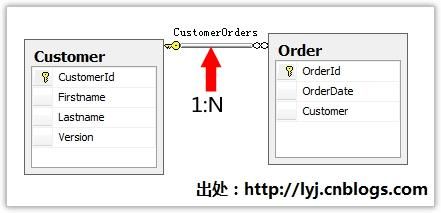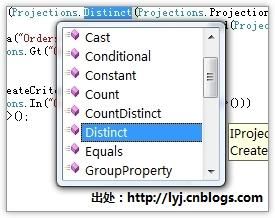NHibernate之旅(10):探索父子(一对多)关联查询
本节内容
- 关联查询引入
- 一对多关联查询
- 1.原生SQL关联查询
- 2.HQL关联查询
- 3.Criteria API关联查询
- 结语
关联查询引入
在NHibernate中提供了三种查询方式给我们选择:NHibernate查询语言(HQL,NHibernate Query Language)、条件查询(Criteria API,Query By Example(QBE)是Criteria API的一种特殊情况)、原生SQL(Literal SQL,T-SQL、PL/SQL)。这一节分别使用这三种方式来关联查询。
首先看看上一篇我们为Customer和Order建立的父子关系:
一对多关联查询
1.原生SQL关联查询
在关系模型中:可以使用子表作为内连接查询Customer,像这样:
select * from Customer c inner join Order o on c.CustomerId=o.CustomerId where o.CustomerId=<id of the Customer>
使用父表作为内连接查询Order,像这样:
select * from Oder o inner join Customer c on o.CustomerId=c.CustomerId where o.OrderId=<id of the Order>
下面我们来看看在NHibernate中使用原生SQL查询。这篇来完成查询订单在orderData之后的顾客列表不同查询的写法。
public IList<Customer> UseSQL_GetCustomersWithOrders(DateTime orderDate)
{
return _session.CreateSQLQuery("select distinct {customer.*} from Customer {customer}"+
" inner join [Order] o on o.Customer={customer}.CustomerId where o.OrderDate> :orderDate")
.AddEntity("customer", typeof(Customer))
.SetDateTime("orderDate", orderDate)
.List<Customer>();
}
具体情况是:实例化IQuery接口;使用ISession.CreateSQLQuery()方法,传递的参数是SQL查询语句;{Customer.*}标记是Customer所有属性的简写。 使用AddEntity查询返回的持久化类,SetDataTime设置参数,根据不同类型,方法名不同。
2.HQL关联查询
查询订单在orderData之后的顾客列表的HQL关联查询写法:
public IList<Customer> UseHQL_GetCustomersWithOrders(DateTime orderDate)
{
return _session.CreateQuery("select distinct c from Customer c inner join c.Orders o where o.OrderDate > :orderDate")
.SetDateTime("orderDate", orderDate)
.List<Customer>();
}
这里使用基于面向对象的HQL,一目了然,符合面向对象编程习惯。
写个测试用例测试UseHQL_GetCustomersWithOrdersTest()查询方法是否正确:
[Test]
public void UseHQL_GetCustomersWithOrdersTest()
{
IList<Customer> customers = _relation.UseHQL_GetCustomersWithOrders(new DateTime(2008, 10, 1));
foreach (Customer c in customers)
{
foreach (Order o in c.Orders)
{
Assert.GreaterOrEqual(o.OrderDate, new DateTime(2008, 10, 1));
}
}
foreach (Customer c in customers)
{
Assert.AreEqual(1, customers.Count<Customer>(x => x == c));
}
}
首先调用UseHQL_GetCustomersWithOrders()方法查询订单在2008年10月1号之后的顾客列表,遍历顾客列表,断言顾客为预期的1个,他的订单时间在2008年10月1号之后。OK!测试成功。注意:这个测试用例可测试本篇所有的关联查询。
3.Criteria API关联查询
我们使用CreateCriteria()在关联之间导航,很容易地在实体之间指定约束。这里第二个CreateCriteria()返回一个ICriteria的新实例,并指向Orders实体的元素。在查询中子对象使用子CreateCriteria语句,这是因为实体之间的关联我们在映射文件中已经定义好了。还有一种方法使用CreateAlias()不会创建ICriteria的新实例。
这个例子返回顾客列表有重复的,不是我们想要的结果。
public IList<Customer> UseCriteriaAPI_GetCustomersWithOrders(DateTime orderDate)
{
return _session.CreateCriteria(typeof(Customer))
.CreateCriteria("Orders")
.Add(Restrictions.Gt("OrderDate", orderDate))
.List<Customer>();
}
预过滤
使用ICriteria接口的SetResultTransformer(IResultTransformer resultTransformer)方法返回满足特定条件的Customer。上面例子中使用条件查询,观察其生成的SQL语句并没有distinct,这时可以使用NHibernate.Transform命名空间中的方法或者使用NHibernate提供的NHibernate.CriteriaUtil.RootEntity、NHibernate.CriteriaUtil.DistinctRootEntity、NHibernate.CriteriaUtil.AliasToEntityMap静态方法实现预过滤的作用。那么上面的查询应该修改为:
public IList<Customer> UseCriteriaAPI_GetCustomersWithOrders(DateTime orderDate)
{
return _session.CreateCriteria(typeof(Customer))
.CreateCriteria("Orders")
.Add(Restrictions.Gt("OrderDate", orderDate))
.SetResultTransformer(new NHibernate.Transform.DistinctRootEntityResultTransformer())
//或者.SetResultTransformer(NHibernate.CriteriaUtil.DistinctRootEntity)
.List<Customer>();
}
这个例子从转换结果集的角度实现了我们想要的效果。
投影
调用SetProjection()方法可以实现应用投影到一个查询中。NHibernate.Criterion.Projections是Projection的实例工厂,Projections提供了非常多的方法,看看下面的截图,下拉列表中的方法是不是很多啊:
现在可以条件查询提供的投影来完成上面同样的目的:
public IList<Customer> UseCriteriaAPI_GetDistinctCustomers(DateTime orderDate)
{
IList<int> ids = _session.CreateCriteria(typeof(Customer))
.SetProjection(Projections.Distinct(Projections.ProjectionList()
.Add(Projections.Property("CustomerId"))
)
)
.CreateCriteria("Orders")
.Add(Restrictions.Gt("OrderDate", orderDate))
.List<int>();
return _session.CreateCriteria(typeof(Customer))
.Add(Restrictions.In("CustomerId", ids.ToArray<int>()))
.List<Customer>();
}
我们可以添加若干的投影到投影列表中,例如这个例子我添加一个CustomerId属性值到投影列表中,这个列表中的所有属性值都设置了Distinct投影,第一句返回订单时间在orderDate之后所有顾客Distinct的CustomerId,第二句根据返回的CustomerId查询顾客列表。达到上面的目的。这时发现其生成的SQL语句中有distinct。我们使用投影可以很容易的组合我们需要的各种方法。

